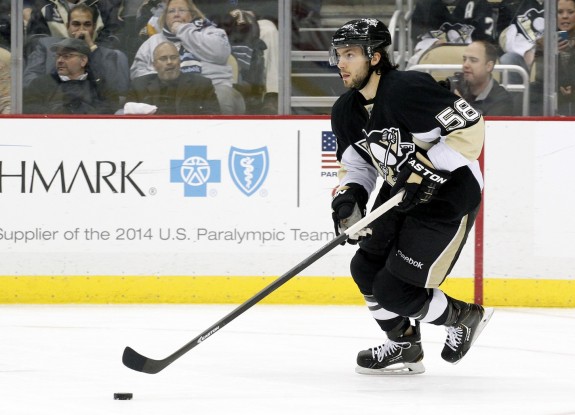
Click here to read Part I from yesterday, if you haven’t already.
To summarize, the Penguins finished the season ranked in the bottom half of the league in FenClose, an even-strength, attempted-shot-differential statistic that is often connected to playoff success.
The question remains: why has this happened, and should it be cause for concern?
Here are five reasons to consider, with clips from recent games for examples.
1. The New Defensive Zone System
The Penguins have made more system changes this season than any year in the Dan Bylsma era.
Is that a result of Bylsma maturing as a head coach (adjustments have always been his weakness)? Does this reflect the influence of new assistant coach Jacques Martin?
Probably a little of both.
The Penguins have tinkered with a variety of trapping systems in the neutral zone (the 1-3-1 early in the season and most recently a 1-2-2 trap).
In the defensive zone, all five skaters have been collapsing in front of the net far more than ever. Most teams in the league are adopting this strategy, which was always used by Jacques Martin’s Montreal Canadiens teams.
Martin’s 2010 Habs pulled off incredible upsets of the Washington Capitals and Pittsburgh Penguins by protecting the area in front of goaltender Jaroslav Halak, allowing huge volumes of shots from bad angles, and capitalizing on offensive opportunities when they were created.
They also ranked 29th of 30 teams in FenClose at 46% in the regular season, yet advanced to the playoffs. They ranked 10th of 16 playoff teams at 45%, yet advanced to the Eastern Conference Finals.
Were the Habs just a fluke team riding an incredibly hot goalie, or does Martin’s system defy the odds?
The Penguins now collapse five players below the top of the circles when the puck is down low and often only activate one forward to attack the puck carrier when it rotates to the top of the zone:
Again, this isn’t unique to the Penguins. It’s just that they’ve typically played higher in the zone and more aggressive in the past, looking to create turnovers or spring wingers for fast breaks.
One way to judge the impact of this change is to look at the shots reaching goaltender Marc-Andre Fleury.
Fleury faced just 24.5 even strength shots per 60 mins this year, the lowest of his career. Last season, by comparison, Fleury faced 26.7 shots/60 (and backup Tomas Vokoun faced 29.2). Fleury has improved his ability to track long shots through traffic — adopting some of the tactics used by LA Kings goalie Jonathan Quick — and the more conservative defensive style provides him additional insulation.
From a FenClose or shot differential perspective, it also limits the quick transition opportunities that became the hallmark of Bylsma’s Penguins teams.
Less shots allowed, but also less shots generated.
Will This Trend Continue? Yes, and there’s reason to believe it may not be a problem. Even strength scoring drops about 20% from the regular season to the playoffs. A more conservative style should suit them well.
________________________________
2. Turnovers on the Breakout
One of the biggest problems for the Penguins this season has been the huge number of turnovers by defensemen in their own zone. The issue became alarming this spring when Brooks Orpik, Rob Scuderi, Deryk Engelland, and Robert Bortuzzo made up four of the top six healthy defensemen.
https://twitter.com/Jay32600/status/456063864656773120
Engelland and Bortuzzo simply don’t have the ability to make accurate breakout passes under pressure — although Bortuzzo is getting better.
Oprik and Scuderi simply don’t have the confidence, as their skills and quickness begin to wither away with age. We’ve covered Orpik’s struggles in this space before, and Scuderi hasn’t been the same since breaking his leg in the fall.
Both players panic when the puck is on their stick in the defensive zone and just slap it to the corner, even when they’re not under pressure.
Quickly clearing the puck from the front of the net isn’t a bad thing by any means, but panic plays have been the norm, not the exception.
Without Paul Martin and Kris Letang in the lineup to clean up the mess, the Penguins were getting pinned in their own zone for 30, 50, or 80 seconds at a time.
Will This Trend Continue? Yes and No. The return of Martin and Letang will really improve the breakout, but the lack of confidence for Scuderi and Orpik will be a huge issue if teams start to pressure those two.
________________________________
3. Defensemen Aren’t Joining the Rush as Often
This probably is tied to the more conservative defensive zone system.
Pittsburgh used to rely heavily on defensemen to join the rush as a ‘fourth forward’ to create odd-man scoring opportunities. As you’d expect, it also left them incredibly vulnerable to teams that could transition the puck quickly and counterattack.
Activating the defense — as it’s often referred to by coaches — has been minimal this year.
The Penguins forwards still look to pass to the defensemen trailing the play, but this is more a result of open passing lanes as opposed to simply out-numbering opponents on the rush.
Will This Trend Continue? Yes. There’s no reason to believe the Penguins will go back to their old ways in the playoffs all of a sudden. It’ll take away their vulnerability to the counterattack, but it’ll also minimize the impact that a player like Kris Letang can have on a series.
The style of the specific opponent will determine whether this is a positive or negative system change for Pittsburgh.

________________________________
4. Fancy Passes, Turnovers, and an Unwillingness to Shoot
This is a tough one to explain.
In one sense, Sidney Crosby has been the most dominant player in the league for long stretches at a time this season. In another sense, he could’ve been so much more effective.
Crosby falls into funks where he insists on overpassing — and his linemates then fall into the same trap. Instead of taking a high-percentage shot on a rush, he spins around with a blind backhand pass that leads to a turnover.
It’s reached a point where some teams are already assuming Crosby will think pass first, even when he’s wide open.
The Penguins pull off these moves in practice all the time, but one careless turnover in the playoffs can mean one goal in your net.
One goal in your net can mean the end of the series and the end of your season.
@TheHockeyWriter @MikeColligan #Pens R talented, but try 2 often 2 make the perfect play by passing 2 much. Shoot the puck is our refrain.
— Leslie W. McIntire (@LeslieWMcIntire) April 15, 2014
Will This Trend Continue? Impossible to tell. It can change from game to game depending on Crosby’s mentality. It usually gets worse if the Penguins are scoring a lot of goals. A first round rout of the Blue Jackets could make this a concern in the second round.
________________________________
5. Unable to Establish an Offensive Zone Cycle
@MikeColligan In a word, yes, but only on half the team.
— Jesse Marshall (@jmarshfof) April 15, 2014
This one falls squarely on the Penguins’ third and fourth lines.
Checking lines don’t necessarily need to generate shot volume or scoring opportunities, but they need to grind down opposing teams and establish sustained pressure in the offensive zone.
The Penguins checking units have done neither.
If you’ve watched the Penguins this season, try to think about the 13 goals Brandon Sutter has scored. Other than a few recent goals during a stint on the top lines, almost every one I can remember has come off the rush.
He knows how to weave through the neutral zone and generate odd-man opportunities, but his line is often one-and-done when it comes to scoring chances.
No pressure in the corners, no cycling of the puck is established, and no sustained zone time results.
The puck goes the other way, the Penguins get pinned in their own end as a result of turnovers the defense, and the problems continue until the puck is in the back of the net.
Will This Trend Continue? Yes. The Penguins simply aren’t deep enough this year. They’ll have to rely on an extremely top-heavy forward group and hope that a deeper team like Boston doesn’t make them pay.
__________________________________
Comments are closed.